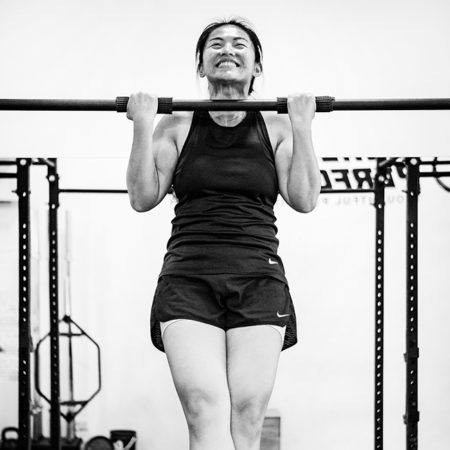
Given the absolute strength differences between men and women, a chin-up is an excellent challenge for ladies with strength goals. I train a number of women, so I decided to challenge my students (and myself) by embarking on an audacious one-year long plan to help as many of my female students perform their first chin-up as possible.
Start at the Beginning
The adage goes, “If you don’t assess, it’s just a guess.” Assessments are essential before beginning any training plan with a specific goal in mind. They help us see where the majority of training time must be spent and then choose the best route to get there. I will outline my assessment process below but first let’s agree that an appropriate prerequisite amount of strength must be present for skills to be expressed.
My current go-to assessments are:
- Artificially Controlled Environment (A.C.E)—This is a term known in StrongFirst for assisting the movement to find exactly what current sticking point the student needs to overcome. Applying ACE to the movement shows us if the student needs a ton of support or if it’s just at a sticking point.
- Is the student able to hold an isometric contraction for ten seconds at the three main chin-up sticking points: elbow angle at 170 degrees, 90 degrees, and the flexed arm hang with the chin above the bar?
- Is the student able to do a 10-second lowering phase from the flexed arm hang down to a fully straight arm position?
For this article, I am going to assume the student has been training for at least a few months and is close enough to accomplish the assessments, meaning they surpass at least half the time recommended in numbers 2 and 3 above. If so, this article will serve to build maximal strength in sticking points and condition the neurological system for successful chin-ups.
If they fail in one or more of these positions, they need to build a base level of strength which is a whole different program altogether.
Build Max Strength Using Yielding Isometrics, Supramaximal Eccentric, and Eccentric Quasi-Isometrics
This article will focus on yielding isometrics (which is holding a weight at a specific position and preventing it from yielding against gravity), supramaximal eccentrics (utilizing a weight on the slow-stretch portion that is heavier compared to the shortening portion of the lift), and eccentric quasi-isometrics (a combination of slow stretch and pauses at specific angles). This varied approach will allow us to emphasize different strength curves as well as improve the nervous system output.
Isometric training comes with a variety of benefits. You can sustain maximal tension for a longer period of time as compared to dynamic contractions. It aids in improving strength at angles where the strength curve is diminished. And it is less metabolically expensive and thus will not cause muscle damage. Most of the movement choices during this phase will be in the vertical pulling force vector because it will more closely replicate the contraction type and directional force required in chin-ups and therefore yield greater carry over.
Because eccentric training recruits fewer motor unit during contraction the mechanical load per motor unit is heightened. This is why eccentric training can generate up to 140% more tension than concentric training.
Hurdles to Avoid
One thing to take note of when programming the different phases of contraction is the interference effect between neuromuscular aspects of training. Try not to mix eccentric, isometric, and concentric phases all in one day, especially if you are using the same force vector.
Skill Development
Only when a student has been able to pass steps two and three in the assessment phase do I move on to the skill development which can be done simultaneously with absolute strength. This is where resistance bands come in to play. On a side note, I have found that using a band with resistance heavier than 40-80 pounds is not helpful because the strength curve is altered too much. The bottom portion of the chin-up is where most people are weakest, so too heavy of a band will not let them build strength where they need it. In terms of training frequency, given that skills need to be practiced often, I have found that three to five times per week is best.
The Program
Now with all that information above, let’s piece things together into a periodized program. Rep count is written as reps/sets, for example: 10/3 means three sets of ten reps. You will also see a tempo written for some of the movements. The first one listed below is 1-1-1-2. This means one second for eccentric (lowering phase), one second at full extension, one second for concentric (shortening phase), and a two-second pause at the fully flexed position. A1 and A2 below together represent a superset. After you finish all sets of A then proceed to B. Remember to rest as needed taking up to a full three minutes after finishing one set of Series A or Series B.
Phase 1: Absolute Strength, Weeks 1-4
Day #1
- A1: Supra Maximal Yielding Eccentrics x 8-15 seconds/5
- Rest 30 seconds
- A2: Arch Back Scapular Pullups x 10/3
- Rest up to three minutes
- B1: Ground Rows x 6-8/4 (at 1-1-1-2 tempo)
- Rest 30 seconds
- B2: Ab Wheel x 3-5/5 (at 4-1-1-1 tempo)
- Rest 90 seconds
Day #2
- A1: Eccentric Quasi Isometric x 2/5 (Descend with control, 5 seconds pause at 90 degrees, descend with control, 5 seconds pause at 170 degrees)
- Rest 30 seconds
- A2: Supinated Arch Back Scapular Pullups x 10/3
- Rest up to three minutes
- B1: Supinated Ring Row x 6-8/4 (at 1-1-1-2 tempo)
- Rest 30 seconds
- B2: Ab Wheel x 3-5/5 (at 4-1-1-1 tempo)
- Rest 90 seconds
Phase 2: Skill Development (2-3 weeks), Weeks 1-3
Day #1
- A: Banded chin-ups—one rep on the minute for a total of ten reps
- B1: Eccentric Quasi Isometric at 110% body weight x 2/5 (Descend with control, 5 seconds pause at 90 degrees, descend with control, 5 seconds pause at 170 degrees)
- Rest 30 seconds
- B2: Supinated Arch Back Scapular Pullups x 10/3
- Rest up to three minutes
Day #2
- A: Banded chin-ups—one rep on the minute for a total of ten reps
- B1: Supra Maximal Yielding Eccentrics x 8-15 seconds/5 (Use a spotter or step up to start at the top and descend with additional weight of 20% of bodyweight)
- Rest up to three minutes
- B2: Arched Back Scapula pullups x 10/3
- Rest up to three minutes
Day #3
- Same as Day #1
If you or your students have not achieved a chin-up yet, it is a feat of strength that you should definitely work toward. And the method I have briefly outlined above is one I’ve used successfully with many people. As with all programming, remember in the end it must be tailored to the student’s ability and physical limitations. Not everyone followed this specific program, these are simply suggestions on how you may progress yourself or a student to a solid chin-up. Remember that a good foundation must be present before attempting the above protocol.
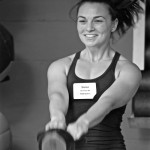
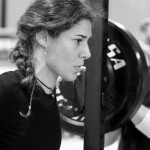
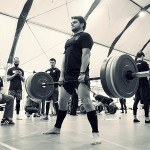
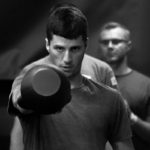

i see some Thibadeu inspiration
Its Yuri Verkhoshansky inspiration
Would love to read part 1 as well!
Hi Steven,
Thanks for taking the time to read this.
I will submit it very soon 🙂
You speak of a certain pre-requisite of strength needs to be had before achieving the iso holds at the 3 different angles and a 10 or more second eccentric phase of a chin up. My question is, what are your benchmarks before getting someone to hang from a chin up bar? I have had plenty of clients say how much they want to achieve their first pull up but lack the grip strength to dead hang for 30/seconds or perform ring rows with perfect technique/scapular rhythm. I really enjoyed reading the layout of this program, I am just curious of your strength tests before a student goes for a pull-up?
Hi Randy,
Thank you for taking the time to read this article.
My initial article was actually double the length of this and what you are seeing here is actually part two. As it was too long, I had to leave the whole of how part 1 out.
As you mentioned, the pre requisites at least from what I find is
1)Being able to hold on to the pull up bar for 3 sets of 30s
2) Been doing some form of rowing, pulling, hanging and carrying for a good 2-3 months
There is no finite definition but the reason why I mention 2-3 months of the above is it prehabs the rotator cuff and elbows for chin up work.
Sure, I’ve gotten ladies to chin up in 2 months or less but for most of the general public, their joints are not conditioned and they will pay for it in the future with medial epicondylitis or rotator cuff issues
Feel free to ask me any more questions 🙂
I would have preferred this article in English…a goal of lockdown is a Chin Up after reading this I thought why bother looks more difficult than the actual activity.
Hi Melanie. Isn’t the program in English?
Let me know if you need any clarifications and I will help you out.